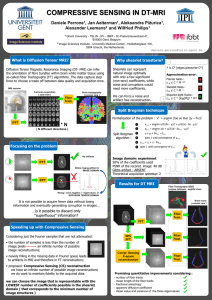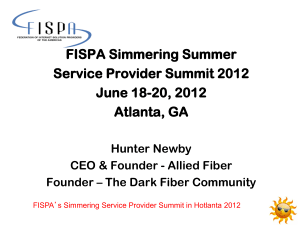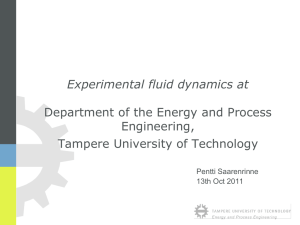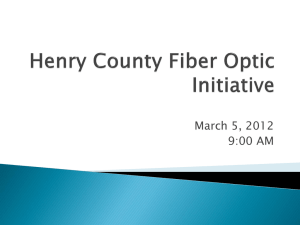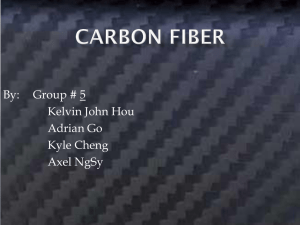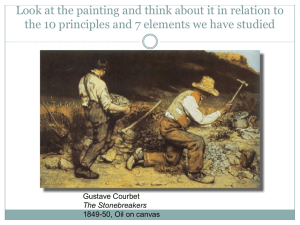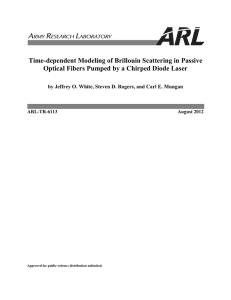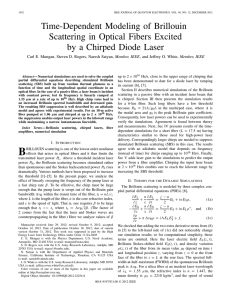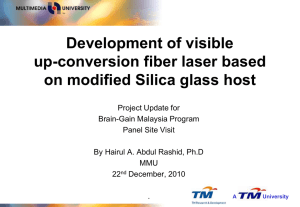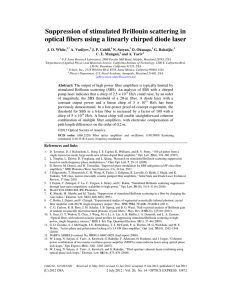Document
advertisement
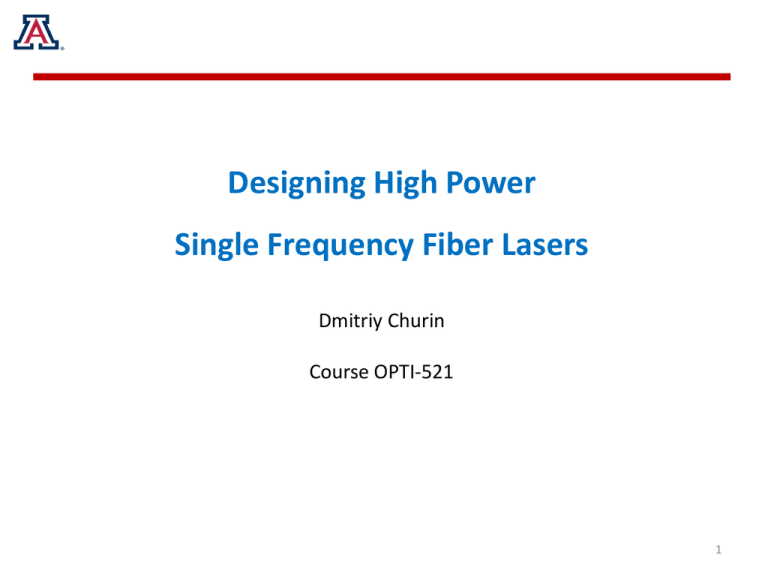
Designing High Power Single Frequency Fiber Lasers Dmitriy Churin Course OPTI-521 1 Overview –What is a single frequency laser –Applications of single frequency lasers – Identifying the limitation of the fiber single frequency lasers – Stimulated Brillouin Scattering – Gradient of temperature of the fiber –Applying strain to the fiber and choice of the epoxy 2 Single frequency laser 𝐸 = 𝐸0 exp 𝑖𝑘𝑧 − 𝑖𝜔𝑡 + 𝑐. 𝑐. But we really have: Lc – coherence length 𝐿𝑐 = 𝑠𝑝𝑒𝑒𝑑 𝑜𝑓 𝑙𝑖𝑔ℎ𝑡 𝑙𝑖𝑛𝑒𝑤𝑖𝑑𝑡ℎ 𝑜𝑓 𝑡ℎ𝑒 𝑙𝑎𝑠𝑒𝑟 3 Displacement measurement 2 I I 0 1 cos 2 n z Record accuracy– 2 nm 4 Velocity measurement Doppler effect: f0 2V f0 V POLYTEC Velocimeter: Dimensions, mm Wavelength Laser power Working distance [mm] Min. velocity [m/min] Max. velocity [m/min] 300 x 120 x 110 690 nm max. 25 mW 200 1,500 0.3 2.11 875 6,211 5 Laser Atom Cooling Rubidium atoms: E ( 5 S 1 2 5 P1 2 ) 1 . 59 eV 1 2 1 2 2 mm 786 nm Ek 3 m (f ) 2 kT T 2 2 3k T ( f 10 MHz ) 0 . 21 K o T ( f 0 . 1 MHz ) 21 K o record 1 K o Six laser beams converge from three orthogonal directions to slow the atoms that happen to pass through the volume where the beams intersect. To hold and trap the atoms in this region, a magnetic induction field is created by two coils positioned on either side of the overlap volume. 6 Acoustic Vibration Measurements ~1 mW DFB fiber laser f 10 kHz 7 Other Applications Coherent Beam Combining IPG : CW Fiber Laser 150 W, f ~ 100 kHz Spectroscopy with high resolution Fine structure: E Ry 1 10 GHz Hyperfine structure: E Ry 0 . 1 1 MHz 2 4 Fiber Optic Communication 10 Gbit/s per channel. Up to terabit/s with wavelength division multiplexing (100 channel per one fiber) – Stable single source is required 8 What is Stimulated Brillouin Scattering (SBS)? λ λ L 1. Field of a single frequency laser 2. Medium “sees” the intensity of the light 3. It creates variation of the density of the material (electrostriction) that travels with the speed of sound -> variation of refractive index. Effectively we have an induced moving Bragg mirror. 4. Incident light reflects back. We can get up to 99% of reflection. Shift due to the Doppler effect. Pump Brillouin scattering 9 Brillouin Spectrum Profile 2𝑛𝑣 Ω𝐵 = 𝜆 ΩB is a frequency shift from the laser signal and it is defined by the medium properties. ΓB is full width at half maximum (FWHM) level of the Brillouin spectrum. gp is Brillouin gain value at the maximum. It has a value of ~5·10-11 m/W. It cannot be modified significantly. 10 Threshold for SBS 𝑔𝐵 𝑃𝑐𝑟 𝐿𝑒𝑓𝑓 ≈ 21 𝐴𝑒𝑓𝑓 What can we do to get Pcr as large as possible? 1. Decrease the effective length (interaction length between medium and light). Even with the highest concentration of dopants in active fiber the minimal length is about 30cm. 2. Increase the modal area of the fiber. The limit of the mode diameter for the single mode fiber is ~30 microns. At larger diameters the fiber stops guiding the light. Pcr for such fiber amplifier would be at the level of ~1kW. If we need to build a higher power laser or pulsed laser with peak power >1kW and pulse duration >10ns we have to develop other methods to suppress the SBS. 11 Temperature dependence CT=1.05MHz/K Temperature gradient along the fiber Enhancement by factor of 5 12 Applying strain to the fiber 𝑔𝐵 𝑃𝑐𝑟 𝐿𝑒𝑓𝑓 ≈ 21 𝐴𝑒𝑓𝑓 Split into 6 individual fibers with 1/6 of the total length CS=0.464GHz/% 13 Choice of the epoxy 𝜀= 𝐹 𝐴∙𝐸 𝐹 For 2% strain: 𝑑2 125𝜇𝑚2 𝐴=𝜋 =π 2 4 𝐸 = 82𝐺𝑃𝑎 (Fused Silica) 𝑑 Epoxy 𝐿 Fiber 𝐹 = 𝜀 ∙ 𝐴 ∙ 𝐸 = 17.7𝑁 How much of the epoxy we need? Long term strength is 3.5𝑀𝑃𝑎 (2216 epoxy) 𝐴𝑒 = 𝜋 ∙ 𝑑 ∙ 𝐿 Something else to consider: 1. Shrinkage of the epoxy 2. Using epoxy at high temperatures 𝐹 3.5𝑀𝑃𝑎 Need to use = =≫ 𝐿 = 5𝑐𝑚 another epoxy 𝐴𝑒 4 Safety Factor 14 Conclusion Higher power/peak power single frequency fiber lasers need to have high suppression of Stimulated Brillouin Scattering. Common methods to reduce SBS are: 1. Use of high gain active fiber to reduce the effective length of the fiber 2. Use large core fiber. To further suppress the SBS we need to “modify” the fiber: 1. Apply strain to fiber in steps (enhancement factor of 20). 2. Apply temperature gradient (enhancement factor of 5). 15 Thank you 16 Applying strain to the fiber Enhancement by factor of 20! 𝑔𝐵 𝑃𝑐𝑟 𝐿𝑒𝑓𝑓 ≈ 21 𝐴𝑒𝑓𝑓 𝑃 𝑧 𝑑𝑧 = 𝑐𝑜𝑛𝑠𝑡 17

